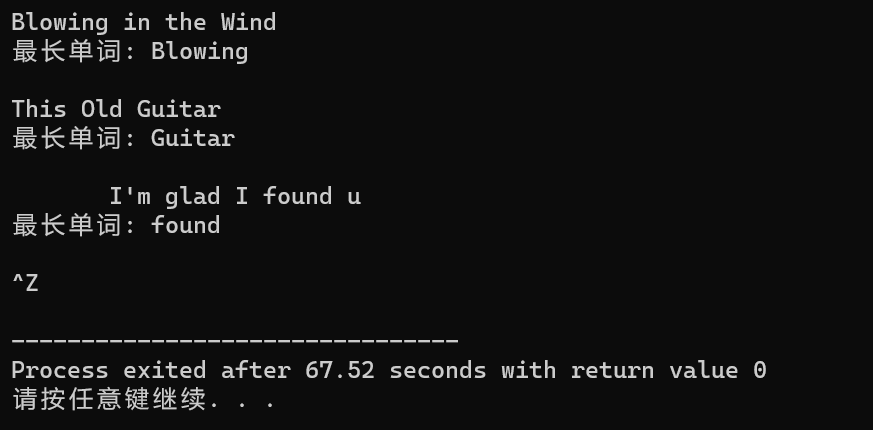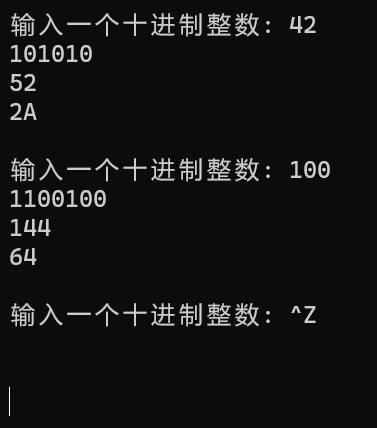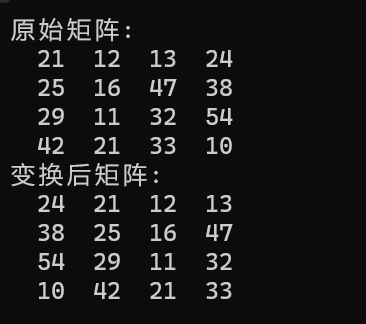实验4
#define _CRT_SECURE_NO_WARNINGS #include <stdio.h> #include <math.h> #include <stdio.h> #define N 4 void test1() { int a[N] = { 1, 9, 8, 4 }; int i; // 输出数组a占用的内存字节数 printf("sizeof(a) = %d\n", sizeof(a)); // 输出int类型数组a中每个元素的地址、值 for (i = 0; i < N; ++i) printf("%p: %d\n", &a[i], a[i]); // 输出数组名a对应的值 printf("a = %p\n", a); } void test2() { char b[N] = { '1', '9', '8', '4' }; int i; // 输出数组b占用的内存字节数 printf("sizeof(b) = %d\n", sizeof(b)); // 输出char类型数组b中每个元素的地址、值 for (i = 0; i < N; ++i) printf("%p: %c\n", &b[i], b[i]); // 输出数组名b对应的值 printf("b = %p\n", b); } int main() { printf("测试1: int类型一维数组\n"); test1(); printf("\n测试2: char类型一维数组\n"); test2(); return 0; }

1.是连续存放的;每个占4个字节;一样
2.是连续存放的;每个占1个字节;一样
#define _CRT_SECURE_NO_WARNINGS #include <stdio.h> #include <math.h> #include <stdio.h> #define N 2 #define M 4 void test1() { int a[N][M] = { {1, 9, 8, 4}, {2, 0, 4, 9} }; int i, j; // 输出int类型二维数组a占用的内存字节数 printf("sizeof(a) = %d\n", sizeof(a)); // 输出int类型二维数组a中每个元素的地址、值 for (i = 0; i < N; ++i) for (j = 0; j < M; ++j) printf("%p: %d\n", &a[i][j], a[i][j]); printf("\n"); // 输出int类型二维数组名a, 以及,a[0], a[1]的值 printf("a = %p\n", a); printf("a[0] = %p\n", a[0]); printf("a[1] = %p\n", a[1]); printf("\n"); } void test2() { char b[N][M] = { {'1', '9', '8', '4'}, {'2', '0', '4', '9'} }; int i, j; // 输出char类型二维数组b占用的内存字节数 printf("sizeof(b) = %d\n", sizeof(b)); // 输出char类型二维数组b中每个元素的地址、值 for (i = 0; i < N; ++i) for (j = 0; j < M; ++j) printf("%p: %c\n", &b[i][j], b[i][j]); printf("\n"); // 输出char类型二维数组名b, 以及,b[0], b[1]的值 printf("b = %p\n", b); printf("b[0] = %p\n", b[0]); printf("b[1] = %p\n", b[1]); } int main() { printf("测试1: int型两维数组"); test1(); printf("\n测试2: char型两维数组"); test2(); return 0; }

1.是按行连续存放的;4;一样
2.是按行连续存放的;1;一样
3.差16,差4
#define _CRT_SECURE_NO_WARNINGS #include <stdio.h> #include <math.h> #include <stdio.h> #include <string.h> #define N 80 void swap_str(char s1[N], char s2[N]); void test1(); void test2(); int main() { printf("测试1: 用两个一维char数组,实现两个字符串交换\n"); test1(); printf("\n测试2: 用二维char数组,实现两个字符串交换\n"); test2(); return 0; } void test1() { char views1[N] = "hey, C, I hate u."; char views2[N] = "hey, C, I love u."; printf("交换前: \n"); puts(views1); puts(views2); swap_str(views1, views2); printf("交换后: \n"); puts(views1); puts(views2); } void test2() { char views[2][N] = { "hey, C, I hate u.", "hey, C, I love u." }; printf("交换前: \n"); puts(views[0]); puts(views[1]); swap_str(views[0], views[1]); printf("交换后: \n"); puts(views[0]); puts(views[1]); } void swap_str(char s1[N], char s2[N]) { char tmp[N]; strcpy(tmp, s1); strcpy(s1, s2); strcpy(s2, tmp); }

主要有关地址表示,数组名可以作为该数组的首地址。
#define _CRT_SECURE_NO_WARNINGS #include <stdio.h> #include <math.h> #include <stdio.h> #include <string.h> #include <stdio.h> #define N 80 int count(char x[]); int main() { char words[N + 1]; int n; while (gets(words) != NULL) { n = count(words); printf("单词数: %d\n\n", n); } return 0; } int count(char x[]) { int i; int word_flag = 0; // 用作单词标志,一个新单词开始,值为1;单词结束,值为0 int number = 0; // 统计单词个数 for (i = 0; x[i] != '\0'; i++) { if (x[i] == ' ') word_flag = 0; else if (word_flag == 0) { word_flag = 1; number++; } } return number; }

#define _CRT_SECURE_NO_WARNINGS #include <stdio.h> #include <math.h> #include <stdio.h> #include <string.h> #include <stdio.h> #define N 1000 int main() { char line[N]; int word_len; // 记录当前单词长度 int max_len; // 记录最长单词长度 int end; // 记录最长单词结束位置 int i; while(gets(line) != NULL) { word_len = 0; max_len = 0; end = 0; i = 0; while(1) { // 跳过连续空格 while(line[i] == ' ') { word_len = 0; // 单词长度置0,为新单词统计做准备 i++; } // 在一个单词中,统计当前单词长度 while(line[i] != '\0' && line[i] != ' ') { word_len++; i++; } // 更新更长单词长度,并,记录最长单词结束位置 if(max_len < word_len) { max_len = word_len; end = i; // end保存的是单词结束的下一个坐标位置 } // 遍历到文本结束时,终止循环 if(line[i] == '\0') break; } // 输出最长单词 printf("最长单词: "); for(i = end - max_len; i < end; ++i) printf("%c", line[i]); printf("\n\n"); } return 0; }

#define _CRT_SECURE_NO_WARNINGS #include <stdio.h> #include <math.h> #include <stdio.h> #define N 100 void dec_to_n(int x, int n); // 函数声明 int main() { int x; printf("输入一个十进制整数: "); while (scanf("%d", &x) != EOF) { dec_to_n(x, 2); // 函数调用: 把x转换成二进制输出 dec_to_n(x, 8); // 函数调用: 把x转换成八进制输出 dec_to_n(x, 16); // 函数调用: 把x转换成十六进制输出 printf("\n输入一个十进制整数: "); } return 0; } void dec_to_n(int x, int n) { int a[1000]; if (n == 2) { int b, d=0; while (x != 0) { b = x % 2; x = x / 2; a[d++] = b; } for (int i = d-1; i >= 0; i--) { printf("%d", a[i]); } printf("\n"); } else if (n == 8) { int b, d = 0; while (x != 0) { b = x % 8; x = x / 8; a[d++] = b; } for (int i = d-1; i >= 0; i--) { printf("%d", a[i]); } printf("\n"); } else if (n == 16) { int b, d = 0; while (x != 0) { b = x % 16; x = x / 16; a[d++] = b; } for (int i = d-1; i >=0; i--) { if (a[i] == 10) { printf("A"); } else if (a[i] == 11) { printf("B"); } else if (a[i] == 12) { printf("C"); } else if (a[i] == 13) { printf("D"); } else if (a[i] == 14) { printf("E"); } else if (a[i] == 15) { printf("F"); } else { printf("%d", a[i]); } } printf("\n"); } }

#define _CRT_SECURE_NO_WARNINGS #include <stdio.h> #define N 5 // 函数声明 void input(int x[], int n); void output(int x[], int n); double average(int x[], int n); void bubble_sort(int x[], int n); int main() { int scores[N]; double ave; printf("录入%d个分数:\n", N); input(scores, N); printf("\n输出课程分数: \n"); output(scores, N); printf("\n课程分数处理: 计算均分、排序...\n"); ave = average(scores, N); bubble_sort(scores, N); printf("\n输出课程均分: %.2f\n", ave); printf("\n输出课程分数(高->低):\n"); output(scores, N); return 0; } // 函数定义 // 输入n个整数保存到整型数组x中 void input(int x[], int n) { int i; for (i = 0; i < n; ++i) scanf("%d", &x[i]); } // 输出整型数组x中n个元素 void output(int x[], int n) { int i; for (i = 0; i < n; ++i) printf("%d ", x[i]); printf("\n"); } double average(int x[], int n) { double ave=0.0; for (int i = 0; i < n; i++) { ave += (double)x[i]; } return ave / (double)n; } void bubble_sort(int x[], int n) { for (int i = 0; i <= n - 1; i++) { for (int j = 0; j <= n - 1; j++) { if (x[j] < x[j + 1]) { int temp = x[j]; x[j] = x[j + 1]; x[j + 1] = temp; } } } }

#define _CRT_SECURE_NO_WARNINGS #include <stdio.h> #define N 5 #include <string.h> #define N 5 #define M 20 // 函数声明 void output(char str[][M], int n); void bubble_sort(char str[][M], int n); int main() { char name[][M] = { "Bob", "Bill", "Joseph", "Taylor", "George" }; int i; printf("输出初始名单:\n"); output(name, N); printf("\n排序中...\n"); bubble_sort(name, N); // 函数调用 printf("\n按字典序输出名单:\n"); output(name, N); return 0; } // 函数定义 // 功能:按行输出二维数组中的字符串 void output(char str[][M], int n) { int i; for (i = 0; i < n; ++i) printf("%s\n", str[i]); } void bubble_sort(char str[][M], int n) { char temp[M]; for (int i = 0; i < n-1; i++) { for (int j = 0; j < n-1; j++) { if (str[j][0] > str[j + 1][0]) { strcpy(temp, str[j]); strcpy(str[j], str[j+1]); strcpy(str[j + 1], temp); } } } }

#define _CRT_SECURE_NO_WARNINGS #include <stdio.h> #define N 5 #include <string.h> #define N 5 #define M 20 // 函数声明 int main() { char temp[101]; while (scanf("%s", &temp) != EOF) { int a[10]; int i = 0; int flag = 0; for (int i = 0; i < 10; i++) { a[i] = -1; } for (int j = 0; temp[j]!='\0'; j++) { if (a[temp[j] - 48] == -1) { a[temp[j] - 48] = 1; } else { flag = 1; break; } } if (flag == 1) { printf("YES\n"); } else { printf("NO\n"); } } }

#define _CRT_SECURE_NO_WARNINGS #include <stdio.h> #include <string.h> #define N 100 #define M 4 void output(int x[][N], int n); // 函数声明 void rotate_to_right(int x[][N], int n); // 函数声明 int main() { int t[][N] = { {21, 12, 13, 24}, {25, 16, 47, 38}, {29, 11, 32, 54}, {42, 21, 33, 10} }; printf("原始矩阵:\n"); output(t, M); // 函数调用 rotate_to_right(t, M); // 函数调用 printf("变换后矩阵:\n"); output(t, M); // 函数调用 return 0; } // 函数定义 // 功能: 输出一个n*n的矩阵x void output(int x[][N], int n) { int i, j; for (i = 0; i < n; ++i) { for (j = 0; j < n; ++j) printf("%4d", x[i][j]); printf("\n"); } } void rotate_to_right(int x[][N], int n) { int a[N]; for (int i = 0; i < n; i++) { a[i] = x[i][n-1]; } for (int i = n-1; i >=0; i--) { for (int j = 0; j < n; j++) { if (i == 0)x[j][i] = a[j]; else x[j][i] = x[j][i-1]; } } }



